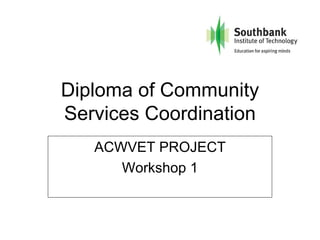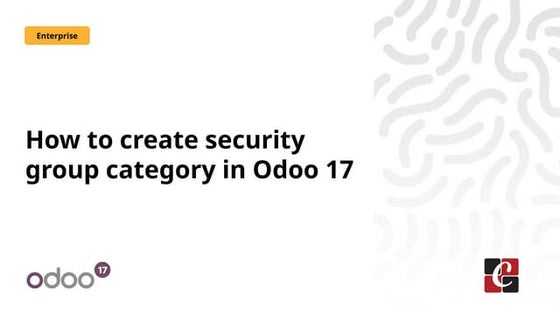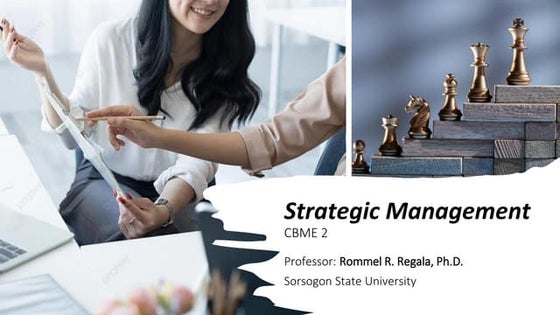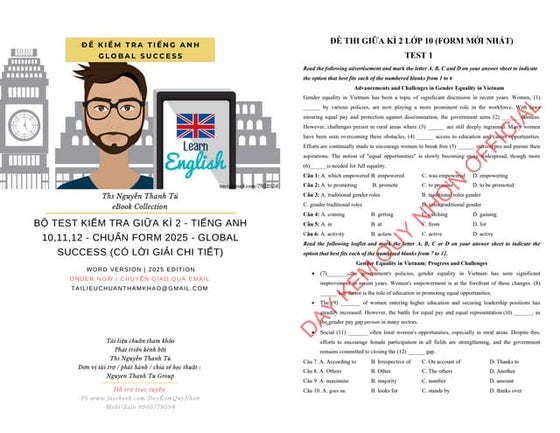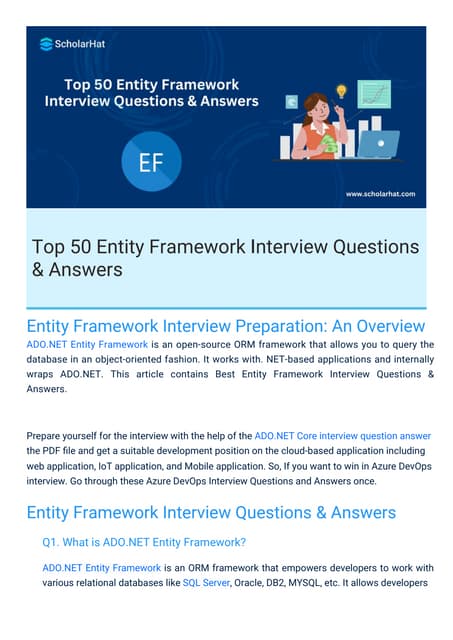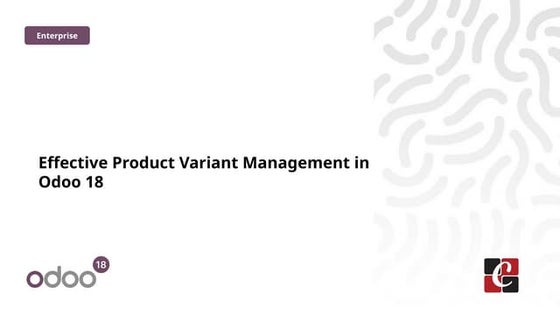Diploma of community services coordination
- 1. Diploma of Community Services Coordination ACWVET PROJECT Workshop 1
- 2. workshop1 ŌĆó CHCORG405D Maintain an effective work environment ŌĆó CHCCS513B Maintain an effective community sector work environment ŌĆó CHCCOM504A Develop, implement and promote effective workplace communication ŌĆó HLTOHS401A Maintain OHS processes
- 3. facebook ŌĆó Student support/discussion page ŌĆó http://www.facebook.com/groups/226399374123781/ ŌĆó SBIT DIPLOMA OF COMMUNITY SERVICES COORDINATION
- 4. ŌĆó On line learning ŌĆó Assessment tasks ŌĆó http://southbank-communityservices.catapult-elearning.com/
- 5. CSS values ŌĆó What is the community services sectors? ŌĆó Values: ŌĆó Holistic ŌĆó Client Centred ŌĆó Needs and rights ŌĆó Duty of care ŌĆó Access and equity ŌĆó Human rights ŌĆó Client safety
- 6. Values of the Community Services Sector ŌĆó Shared Values for the Community Services Sector ŌĆó We value: ŌĆó 1. Human rights ŌĆó 2. Individual and community wellbeing ŌĆó 3. Diversity ŌĆó 4. Aboriginal and Torres Strait Islander self-determination ŌĆó 5. Cooperation and participation ŌĆó 6. Excellence ŌĆó 7. Independence. ŌĆó http://www.qcoss.org.au/sites/default/files/the-charter.pdf 6
- 7. ŌĆó Models ŌĆó Medical ŌĆó Welfare ŌĆó Community development ŌĆó Strengths based perspectives
- 8. Culture ŌĆó Culture/ Values ŌĆó Personal ŌĆó Client ŌĆó Organisational ŌĆó HLTHIR403C? ŌĆō Work Effectively with Culturally diverse Clients and Co workers
- 9. ŌĆó CHCORG405D Maintain an effective work environment ŌĆó CHCCS513B Maintain an effective community sector work environment
- 10. ŌĆó Awards ŌĆó Funding bodies ŌĆó Job descriptions ŌĆó Work Plans ŌĆó Client group ŌĆó Values/ boundaries/ ethics/ ŌĆó Supervision/ PD/ Appraisals ŌĆó Quality Service/ Accreditation/procedures
- 11. ŌĆó CHCCOM504A Develop, implement and promote effective workplace communication
- 12. ŌĆó Overall Communication ŌĆó Verbal - effectiveness ŌĆó Written - effectiveness ŌĆó Conflict ŌĆó Groups
- 13. ŌĆó Effective communication is the process of passing messages to other people or groups. ŌĆó The message must be clear and communicated using a suitable medium. ŌĆó If a message is not understood by the receiver, as it was intended, then communication has not occurred.
- 14. ŌĆó Written documents and presentations need to be: ŌĆó succinct, clear and ŌĆó presented in a logical and sequential way that matches the audience and the purpose of the document ŌĆó Should include: ŌĆó Introduction ŌĆó Body ŌĆó Conclusion ŌĆó Q/A ŌĆō try to anticipate
- 15. ŌĆó What is active listening ŌĆó Paying attention to what is being said rather than considering what you will do or say next. Suspending judgment until the other person has finished what they are saying. Giving appropriate feedback and responses and being prepared to ask relevant questions to ensure common understanding.
- 16. ŌĆó Some of the steps to effective communication. ŌĆó involves sharing information, ensuring it is understood, active listening and intelligent observation. ŌĆó This can be aided by: ŌĆō listen to other peopleŌĆÖs ideas ŌĆō offer feedback and where appropriate positive criticism ŌĆō come to the group prepared by being aware of any background information relevant to the discussion ŌĆō be punctual ŌĆō have a positive attitude to others ŌĆō know everyone's name ŌĆō be prepared to show initiative and offer ideas willingly ŌĆō do not stereotype people you are talking to or about ŌĆō avoid comments that demean others ŌĆō strive to be original yet realistic ŌĆō greet people ŌĆō speak clearly ŌĆō show you are interested when others are talking
- 17. ŌĆó Assertiveness Conflict and resolution
- 18. Appropriate Assertiveness -Three ingredient recipe: ŌĆó When... I hear a voice raised at me ŌĆó I feel... humiliated ŌĆó And what I'd like is that I... can debate an issue with you without ending up feeling hurt.
- 19. The best "I" statement - ŌĆó is free of expectations. ŌĆó delivers a clean, clear statement of how it is from your side and ŌĆó how you would like it to be.
- 20. ŌĆó Conflict ŌĆó I win/You loose ŌĆō aggressive ŌĆó You win/ I loose - passive ŌĆó Win /Win ŌĆō balanced
- 21. The Human Iceberg Appearance Actions Words Emotions Emotions Feelings and Thoughts, Attitudes 21 Beliefs and Values
- 22. Managing Differences CULTURE A CULTURE B Words Words Actions Actions Feelings Feelings Thoughts Thoughts Beliefs Beliefs Values Values Sandra Bennett Caroline Bouten Pinto 22
- 23. ® Culturewise Practice 1. WHAT IS THE CONTEXT? 4. AGREEMENTS Non-negotiable Words Words Actions Actions Negotiable Feelings Feelings Thoughts Thoughts Beliefs Beliefs Values Not important Values 2. COMMUNICATE 2. EDUCATE 3. OUTCOME Caroline Bouten Pinto 23
- 24. ŌĆó HLTOHS401A Maintain OHS processes
- 25. ŌĆóOHS Information ŌĆóInforming others ŌĆóSafety hazards, risk assessment ŌĆóEmergency procedures ŌĆóRecords maintenance
- 26. ŌĆó OHS policy. ŌĆó OHS procedure. ŌĆó OHS code of practice. ŌĆó OHS committee meeting. ŌĆó OHS committee meeting minutes. ŌĆó PPE applicable to your chosen career path. ŌĆó hazard identification tool. ŌĆó risk assessment tool. ŌĆó emergency procedure
- 28. ŌĆó hazard identification, ŌĆó risk assessment and ŌĆó control implementation
- 29. ŌĆó RISK CONTROL ŌĆó You must first do a risk assessment to better be able to plan, introduce and monitor measures to ensure that risks are adequately controlled at all times. ŌĆó Once hazards have been identified and risks assessed, action must be taken to control them. ŌĆó Ideas on how to control risks may come from: ŌĆó regulations or codes of practice which provide control measures for that hazard ŌĆó workers ŌĆó employer organisations and unions ŌĆó government authorities ŌĆó OH&S specialists.
- 30. ŌĆó Hierarchy of control ŌĆó Elimination. Remove the hazard completely from the work area. ŌĆó Substitution. Replace the material or process with something less hazardous. ŌĆó Isolation. Isolate the hazard by controlling or guarding it. ŌĆó Engineering controls. Redesign equipment or work processes to reduce or eliminate risk. ŌĆó Administrative controls. Promote safe practice through policies, processes, training and signage. ŌĆó Personal Protective Equipment (PPE). Use personal protective equipment to minimise risk. ŌĆó Starting with Step 1, each strategy is considered in turn... ŌĆó For example, can this be implemented, will it solve the problem? If this step is not sufficient to manage the hazard, move on to the next until a solution is identified.
- 33. Updates to WHS Legislation ŌĆó From 1st January 2012, the goalposts will be changing ŌĆó National WHS laws to be implemented, not State-based as it has in the past ŌĆó Re-arranging the way that we consider responsibility for WHS compliance ŌĆó Broken down into four categories ŌĆó Includes psychological as well as physical
- 34. Levels of Responsibilities ŌĆó Person Conducting a ŌĆó Need to do what is Business or Undertaking reasonably practicable ŌĆó Officers ŌĆó Workers ŌĆó Due diligence ŌĆó Others ŌĆó Take reasonable care ŌĆó Take reasonable care
- 35. Risk Management ŌĆó Previous requirement was for Risk Management assessments and instructions to be developed for all activities ŌĆó Now, simple solutions can be uniformly agreed without requirement for risk assessment, ie chair trolleys, scaffolding ŌĆó Still up to the primary user of the equipment to assess the risks
- 36. Bullying inclusions ŌĆó WHS expanded to include bullying clauses ŌĆó ŌĆ£Provide and maintain for employees a working environment that is safe and without risks to health so far as is reasonably practicable. ŌĆó Health is defined to include ŌĆśpsychological healthŌĆÖ.ŌĆØ
- 37. ŌĆó Bullying can be: ŌĆō Direct such as verbal abuse, interfering with work equipment or spreading rumours OR ŌĆō Indirect such as deliberate exclusion, setting unreasonable tasks/timelines or withholding vital information ŌĆó Bullying can see claims lodged under: ŌĆō Workers Compensation ŌĆō Equal Opportunity ŌĆō Unfair Dismissal ŌĆō Adverse Action under Fair Work Act 2009
Editor's Notes
- #22: Emphasise the following points: Iceberg Model - Like an iceberg, 90% of what makes us human is invisible. - Appearance, words and actions are visible, but what motivates people is determined by what is under the surface (and not seen). - Historically, when we talk about cross-cultural differences we focus on the visible practices (e.g. music, food, dress, language). - To understand another culture it is important to become aware of the beliefs and values that underpin it. A challenge in this is that no culture clearly articulates its own values. Often it is only when people experience differences (usually in misunderstandings or conflict situations) that they become aware and can start to explore their origins to develop effective cross-cultural strategies.
- #23: Managing Diversity ŌĆō The Third Culture ŌĆó Pose the question ŌĆ£ How do we resolve cultural differences? ŌĆÖ and each participant outlines a strategy. ŌĆó Show Power Point ║▌║▌▀Ż 23 of two icebergs (representing cultures) meeting each other. ŌĆó Discuss how the alignment of thoughts, beliefs and values usually results in friendships and harmonious relationships; but non-alignment results in misunderstandings and tension which can escalate to conflict.
- #24: Using ║▌║▌▀Ż 24, draw attention to the space between, nominating it as ŌĆ£ the third culture ŌĆØ. ŌĆó The Third Culture occurs in the workplace or individual relationships where the differences are acknowledged and discussed and a set of agreements are drawn up to co-exist harmoniously by determining: (i) non-negotiable practices (laws of the land, legislation, regulation and individual practices such as those relating to religion) (ii) negotiable practices, and (iii) not important practices

